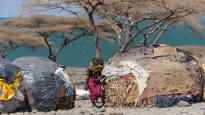Already tens of thousands of people have been forced to flee their homes after floods in desert lakes covered farmland.
For ten years now, the people of western Kenya have had to live with a strange and ever-worsening phenomenon: the lakes in the area are flooded for no apparent reason.
The flooding began about ten years ago. It was discovered by naturalists The Guardian (going to another service) according to the first geologist Simon Onywerewhich was studying the fluoride level of the country ‘s fourth largest lake, Baringo.
The locals stopped him and said they were not interested in the fluoride, but why the lake had risen as early as school.
Onywere returned to his university in Nairobi, where he began studying satellite images of lake surfaces with his colleagues. Researchers found that all the lakes in western Kenya had risen and started flooding.
The phenomenon was similar in small lakes such as Bogoria, Naivasha and Nakuru as well as in large Lake Viktorian and Lake Turkana.
Lake Victoria is the largest lake in Africa, and Turkana is located in the middle of the largest desert in the world.
The flooding was already having consequences. For example, Lake Nakurujärvi, which had previously been surrounded by a nature reserve, had now expanded beyond it.
Flood the refugee problem
The flooding of the lakes has continued and intensified throughout the 2010s. To date, tens of thousands of people have been forced to leave their homes, which have been submerged or whose farms are covered in water.
The Kenyan government has been reluctant to take relief action, even though many people have lost their livelihoods, says The Guardian. The small El Molo tribe, who lived on the shores of Lake Turkana, have been particularly affected by the floods, he says Africa News (switch to another service).
Flooding also has geographical and biological consequences. Turkanajärvi has previously been separated from the small Logipijärvi because there is a tribe of four volcanoes between them. Now the waters of Turkana have risen so high that the lakes have merged. Naivashajärvi has reunited with Oloidenjärvi.
A natural disaster threatens the saltwater Bogoria Lake if the freshwater Baringo Lake begins to join it. Bogoria has its own peculiar, salt-adapted organism world. Among other things, flamingos live on the lake, says the Turk Anadolu Information Office (moving to another service).
The rise in the surface of Lake Baringo accelerated at the onset of the corona pandemic in March 2020, when there was exceptionally heavy rainfall in the area.
When the rains stopped, the residents expected the water level to drop, but the water just kept rising. When the schools opened seven months later after the corona closure, 11 schools in the city of Marigat were completely submerged.
What explains the flooding?
Local residents have been considering the reasons for this special natural phenomenon. For many years, scientists could not explain it.
The strongest guesses were related to the geology of the area. The western part of Kenya in East Africa is part of the East African Funeral Home. The sinking is the result of the division of the region’s continental plate, the African plate, into two parts.
The gap from Mozambique to Lebanon is widening by two millimeters a year. In a few million years, East Africa will secede from the rest of Africa into its own continent.
The floods in Kenya have been blamed for changes in the country. As the continental shelf moves, it is possible that water resources deep in the soil lumen will be released and begin to penetrate the surface.
Maybe still climate change
It did not completely rule out geological causes. UN scientists considered climate change a more likely cause.
While eastern Kenya and the rest of the Horn of Africa are suffering from climate change, with declining rainfall, the situation is different in the western highlands of the country.
In the mountainous region, rainfall has increased in some places and forecasts suggest that it will continue to rise.
Flooding is exacerbated by human activity. The trees that covered the hills have been widely felled, allowing rainwater to flow freely into the ditches at the bottom of the valleys. They carry water to more distant lakes with rising surfaces.
Climate scientists have found that climate change generally reduces rainfall in arid areas and increases it in rainy areas today. An exception to this may be the so-called tropical cycle, which, due to climate change, is intensifying and thus potentially increasing rainfall in some regions, such as parts of Africa.
How to prepare for complex crises such as recurrent floods? You can discuss the topic until Sunday, March 20th. until 11 p.m.
Read more about the tropics:
